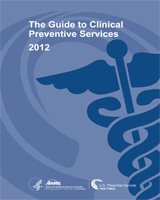From: Recommendations for Children and Adolescents

The Guide to Clinical Preventive Services 2012: Recommendations of the U.S. Preventive Services Task Force.
Rockville (MD): Agency for Healthcare Research and Quality (US); 2012 Oct.
NCBI Bookshelf. A service of the National Library of Medicine, National Institutes of Health.